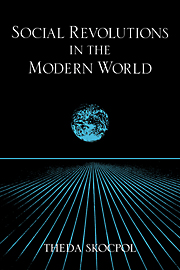Book contents
- Frontmatter
- Contents
- Acknowledgments
- INTRODUCTION
- I DOING MACROSCOPIC SOCIAL SCIENCE
- II MAKING SENSE OF THE GREAT REVOLUTIONS
- 4 Explaining revolutions: In quest of a social-structural approach
- 5 Revolutions and the world-historical development of capitalism
- 6 France, Russia, China: A structural analysis of social revolutions
- III A DIALOGUE ABOUT CULTURE AND IDEOLOGY IN REVOLUTIONS
- IV FROM CLASSICAL TO CONTEMPORARY SOCIAL REVOLUTIONS
- CONCLUSION
- Index
6 - France, Russia, China: A structural analysis of social revolutions
Published online by Cambridge University Press: 05 June 2012
- Frontmatter
- Contents
- Acknowledgments
- INTRODUCTION
- I DOING MACROSCOPIC SOCIAL SCIENCE
- II MAKING SENSE OF THE GREAT REVOLUTIONS
- 4 Explaining revolutions: In quest of a social-structural approach
- 5 Revolutions and the world-historical development of capitalism
- 6 France, Russia, China: A structural analysis of social revolutions
- III A DIALOGUE ABOUT CULTURE AND IDEOLOGY IN REVOLUTIONS
- IV FROM CLASSICAL TO CONTEMPORARY SOCIAL REVOLUTIONS
- CONCLUSION
- Index
Summary
‘A revolution’, writes Samuel P. Huntington in Political Order in Changing Societies, ‘is a rapid, fundamental, and violent domestic change in the dominant values and myths of a society, in its political institutions, social structure, leadership, and government activities and policies’. In The Two Tactics of Social Democracy in the Democratic Revolution, Lenin provides a different, but complementary perspective: ‘Revolutions’, he says, ‘are the festivals of the oppressed and the exploited. At no other time are the masses of the people in a position to come forward so actively as creators of a new social order’. Together these two quotes delineate the distinctive features of social revolutions. As Huntington points out, social revolutions are rapid, basic transformations of socio-economic and political institutions, and – as Lenin so vividly reminds us – social revolutions are accompanied and in part effectuated through class upheavals from below. It is this combination of thoroughgoing structural transformation and massive class upheavals that sets social revolutions apart from coups, rebellions, and even political revolutions and national independence movements.
If one adopts such a specific definition, then clearly only a handful of successful social revolutions have ever occurred. France, 1789, Russia, 1917, and China, 1911–49, are the most dramatic and clear-cut instances. Yet these momentous upheavals have helped shape the fate of the majority of mankind, and their causes, consequences, and potentials have preoccupied many thoughtful people since the late eighteenth century.
- Type
- Chapter
- Information
- Social Revolutions in the Modern World , pp. 133 - 166Publisher: Cambridge University PressPrint publication year: 1994



